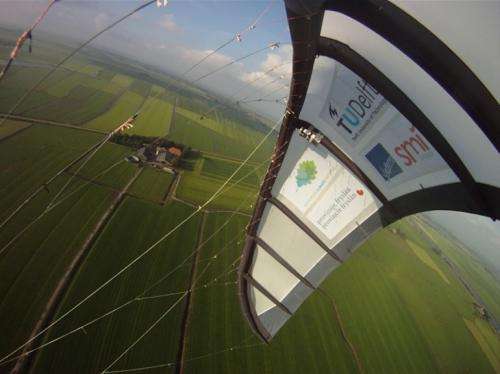July 13, 2013 weblog
Delft professor puts kites high on list for renewable energy

(Phys.org) —The word "kite" at the Delft University of Technology hardly means summertime fun and recreation. Rather, scientists see "kite" as an important airborne wind technology, with advantages lacking in wind turbines. The university's kite team are encouraged by recent tests in a field near the aerospace engineering department at the university. That is where Roland Schmehl, associate professor, who has a background in computational fluid dynamics, continues to explore kite power. In terms of project scope, such kite trials are dwarfed by impressive wind turbines, but that is just the point. Schmehl believes that conventional turbines only scratch the layer of what can be available in wind as an energy resource, if kite power investigations lead to larger-scale developments. A kite can fly higher and may harness steady winds beyond the limit of conventional turbines.
"The first time I came in contact with this technology in 2009 when I took the position at this university, it was amazing for me to see the prototype system that was built by this group, to see how this 25 square meter kite in action on the airfield would fly 70 to 90 kilometers per hour," he said. Seeing the force being generated was for him "an amazing experience." He was convinced then as now that kite technology can make a difference in renewable energy.
Wind turbines are not an entirely stable path, whereas intermittent power is not a problem with kites: the higher you go, the more constantly the wind blows. Added advantages to kites are that they cause less environmental impact and with lower costs.
A 25 square meter sail can produce enough energy to cover the needs of 40 households, he said, in a report this week in The Guardian. The technology involves the device tethered to a generator unit on the ground. The key in getting it all to work is the automatic control and synchronization of the drum/generator module and the flight dynamics of the kite. There is a traction and a retraction phase, a reel-out and reel-in of the tether. Once the cable has completely unwound it is reeled in again. "We rotate the kite into the wind as we pull it back, so essentially the airstream does part of the work for us," he added. They need less energy to reel in the cable.
This is how the team describes the process:
"The system is operated in periodic pumping cycles, alternating between reel-out and reel-in of the tether. During reel-out, the kite is flying figure-eight maneuvers at high speed (70 to 90 km/h). This creates a high traction force (3.1 kN at 7 m/s wind speed) which is converted into electricity by the drum and the connected 20 kW generator. When reaching the maximum tether length, the kite is de-powered by releasing the rear (steering) lines such that the whole wing rotates and aligns with the apparent wind. Using the drum/generator module as a winch, the kite is now pulled back to the initial position to start the next pumping cycle. De-powering reduces the traction force during reel-in by 80 percent and for this reason the energy consumed during reel-in is only a fraction of the energy generated during reel-out."
As for cost, he said in The Guardian that wind-generated energy goes at eight cents per kilowatt hour but his team's projections for large-scale production, with kites of several hundred square meters, would set the price at around two cents.
The regulatory hurdle, however, to go with all this good news is aerial traffic. In Europe, he said that his team needs special permission since kites fly at heights that could interfere with flight routes. The University of Delft meanwhile is looking to Africa, and its rural electricity needs.
Whether from the Netherlands or elsewhere, wind technologies other than turbines are likely to stay in the news, According to a July blog posting from the American Association of Petroleum Geologists, numerous private companies and government labs are working on airborne wind technologies. Makani Power, acquired by Google, has attracted attention in this regard. The company site says the Makani Airborne Wind Turbine is a tethered wing that generates power by flying in large circles where the wind is stronger and more consistent. It eliminates 90 percent of the material used in conventional wind turbines and can access winds at higher altitudes and above deep waters offshore.
The company goal is "utility-scale deployment of airborne turbines in offshore wind farms."
More information:
kitepowerafrica.weblog.tudelft.nl/
www.kitepower.eu/home.html
via Guardian
© 2013 Phys.org




















